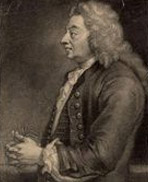Clan Charteris People
 Colonel Francis Charteris, (1672 – 1732)
Colonel Francis Charteris, (1672 – 1732)
Nicknamed “The Rape-Master General,” was a British aristocrat who had earned a substantial amount of money through gambling. He was convicted for raping a servant in 1730. He was subsequently pardoned, but died of natural causes shortly afterwards.
Charteris was born into a well-connected Scottish family and baptised in Amisfield, in Dumfriesshire. However, even before his conviction for rape, he was notorious and despised by many in London as an archetypal rake. He had a serial military career, but was dismissed from service four times; the third by the Duke of Marlborough in Belgium for cheating at cards, and the fourth by Parliament for accepting bribes. Despite his military dismissal, he amassed a considerable fortune, and his daughter, Janet, married James Wemyss, 5th Earl of Wemyss in 1720.
Charteris was the inspiration for the characters in William Hogarths paintings, A Rake’s Progress and A Harlot’s Progress (where he is represented as the fat lecher in the first plate), and in Fanny Hill. He was condemned by Alexander Pope in his Moral Essay III, written in 1733. Parallels were drawn between Charteris’ sexual excesses, and the greed of politicians such as Robert Walpole. Some sources say that he was a founding member of the Hellfire Club, although the famous club founded by Sir Francis Dashwood did not start to meet until 1743. He may have been a member of the original “Hell-Fire Club” founded by Philip Wharton, 1st Duke of Wharton in 1720. Leslie Charteris, creator of Simon Templar, The Saint, was a later admirer, and legally changed his name from Leslie Charles Bowyer-Yin.
Martin Michael Charles Charteris, Baron Charteris of Amisfield GCB GCVO OBE QSO PC (1913–1999)
Confidante and aide to Queen Elizabeth II.
Charteris was the son of Hugo Charteris, Lord Elcho and a brother of the 12th Earl of Wemyss. He was educated at Eton and the Royal Military College Sandhurst and fought in the Middle East during World War II, rising to the rank of Lieutenant-Colonel. On his return, he married Hon. Mary Margesson (a daughter of the 1st Viscount Margesson) on 16 December 1944 and they had three children.
In 1950 he became Private Secretary to then Duchess of Edinburgh and as her Assistant Private Secretary from her accession in 1952 until 1972 when he was promoted to Private Secretary. He held this post until his semi-retirement in 1977 and returned to Eton as its Provost.
Charteris was probably most notable due to an interview he had with The Spectator in 1995 where he described the Duchess of York as “vulgar”, the Prince of Wales as “whiney”, and the Queen Mother as “a bit of an ostrich.”





